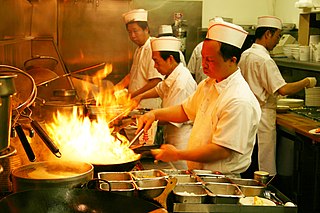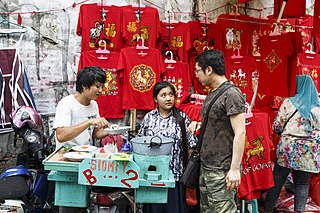
Cantonese or Guangdong cuisine, also known as Yue cuisine, is the cuisine of Guangdong province of China, particularly the provincial capital Guangzhou, and the surrounding regions in the Pearl River Delta including Hong Kong and Macau. Strictly speaking, Cantonese cuisine is the cuisine of Guangzhou or of Cantonese speakers, but it often includes the cooking styles of all the speakers of Yue Chinese languages in Guangdong.

Shanghai cuisine, also known as Hu cuisine, is a popular style of Chinese food. In a narrow sense, Shanghai cuisine refers only to what is traditionally called Benbang cuisine which originated in Shanghai. In a broader sense, it refers to complex styles of cooking developed under the influence of neighboring Jiangsu and Zhejiang provinces.

Malay cuisine is the traditional food of the ethnic Malays of Southeast Asia, residing in modern-day Malaysia, Indonesia, Singapore, Brunei, Southern Thailand and the Philippines as well as Cocos Islands, Christmas Island, Sri Lanka and South Africa.

Hong Kong cuisine is mainly influenced by Cantonese cuisine, European cuisines and non-Cantonese Chinese cuisines, as well as Japanese, Korean and Southeast Asian cuisines, due to Hong Kong's past as a British colony and a long history of being an international port of commerce. Complex combinations and international gourmet expertise have given Hong Kong the labels of "Gourmet Paradise" and "World's Fair of Food".

Fujian cuisine or Fujianese cuisine, also known as Min cuisine, is one of the native Chinese cuisines derived from the cooking style of China's Fujian Province, most notably from the provincial capital, Fuzhou. "Fujian cuisine" in this article refers to the cuisines of Min Chinese speaking people within Fujian. Other cuisines in Fujian include Hakka cuisine, and the ethnic minority cuisines of the She and Tanka people. Fujian cuisine is known to be light but flavourful, soft, and tender, with particular emphasis on umami taste, known in Chinese cooking as xianwei, as well as retaining the original flavour of the main ingredients instead of masking them.

Filipino cuisine is composed of the cuisines of more than a hundred distinct ethnolinguistic groups found throughout the Philippine archipelago. A majority of mainstream Filipino dishes that compose Filipino cuisine are from the food traditions of various ethnolinguistic groups and tribes of the archipelago, including the Ilocano, Pangasinan, Kapampangan, Tagalog, Bicolano, Visayan, Chavacano, and Maranao ethnolinguistic groups. The dishes associated with these groups evolved over the centuries from a largely indigenous base shared with maritime Southeast Asia with varied influences from Chinese, Spanish, and American cuisines, in line with the major waves of influence that had enriched the cultures of the archipelago, and adapted using indigenous ingredients to meet local preferences.

Chinese Indonesian cuisine is characterized by the mixture of Chinese with local Indonesian style. Chinese Indonesians, mostly descendant of Han ethnic Hokkien and Hakka speakers, brought their legacy of Chinese cuisine, and modified some of the dishes with the addition of Indonesian ingredients, such as kecap manis, palm sugar, peanut sauce, chili, santan and local spices to form a hybrid Chinese-Indonesian cuisine. Some of the dishes and cakes share the same style as in Malaysia and Singapore, known as Nyonya cuisine by the Peranakan.

Shandong cuisine, more commonly known in Chinese as Lu cuisine, is one of the Eight Culinary Traditions of Chinese cuisine and one of the Four Great Traditions. It is derived from the native cooking style of Shandong Province, a northern coastal province of China.

Henan or Yu cuisine is an umbrella term used to define the native cooking styles of the Henan province in China. Henan is a province located in Central China and is often also referred to by the names Zhongzhou or Zhongyuan, which means ‘midland’. Being landlocked on all sides, the influence of localized culinary styles are plentiful to be observed in Henan Cuisine. It incorporates a blend of culinary styles from Jiangsu and Beijing, which gives it a unique mix of taste. Henan Cuisine is well known for its taste variety including a blend of sour, sweet, bitter, spicy and salty. There are a wide variety of Henan dishes, including Carp with Fried Noodles in Sweet and Sour Sauce, Grilled Head and Tail of Black Carp, Bianjing Roasted Duck, Stewed Noodles with Mutton, and Spicy Soup. Despite its mix of flavours within its culinary forms, Henan cuisine is not known to take them to the extreme. Rather, Henan cuisine is known for inducing a very moderate and balanced mix of flavours in its dishes. Henan has a long cultural history, which not only left us precious cultural relics and historical sites but also Henan cuisine. Henan is in the central part of China, so it is a fusion of the characteristics of both southern and northern, resulting in a unique local cuisine. Henan cuisine, also known as Yu cuisine, has the honor of being one of China's oldest and most traditional cooking styles. There are more than 50 kinds of cooking methods in preparing Henan cuisine. The history of the province shows its relation to the affinity towards food culture among the people of Henan, where the motive to bring together the different tastes from the north and the south to blend it into one dish.

Shaanxi cuisine, or Qin cuisine, is derived from the native cooking styles of Shaanxi Province and parts of northwestern China.

Padang dish or Minangkabau dish is the cuisine of the Minangkabau people of West Sumatra, Indonesia. It is among the most popular cuisines in Maritime Southeast Asia. It is known across Indonesia as Masakan Padang after Padang, the capital city of Western Sumatra province. It is served in restaurants mostly owned by perantauan (migrating) Minangkabau people in Indonesian cities. Padang food is ubiquitous in Indonesian cities and is popular in neighboring Malaysia and Singapore.

Malaysian Indian cuisine, or the cooking of the ethnic Indian communities in Malaysia, consists of adaptations of authentic dishes from India, as well as original creations inspired by the diverse food culture of Malaysia. Because the vast majority of Malaysia's Indian community are of South Indian descent, and are mostly ethnic Tamils who are descendants of immigrants from a historical region which consists of the modern Indian state of Tamil Nadu and Sri Lanka's Northern Province, much of Malaysian Indian cuisine is predominantly South Indian inspired in character and taste. A typical Malaysian Indian dish is likely to be redolent with curry leaves, whole and powdered spice, and contains fresh coconut in various forms. Ghee is still widely used for cooking, although vegetable oils and refined palm oils are now commonplace in home kitchens. Before a meal it is customary to wash hands as cutlery is often not used while eating, with the exception of a serving spoon for each respective dish.
Nanshi Cuisine Street is located in Nanshi, the busiest section of the city's downtown area of Tianjin, China. It is a national, classic and palatial architectural complex. Nanshi Cuisine Street looks like an ancient walled city enclosed by a circle of neat three-story buildings. There is a crossroad in the "city," and at the centre of the crossroad is a musical fountain. The entire structure is covered with a glass roof. Even not tasting anything, one could be attracted by the buildings itself, which carry a kind of classical ethnic beauty. The green glazed roof tile, colored vivid pattern compel the admiration.

Betawi cuisine is rich, diverse and eclectic, in part because the Betawi people that create them were composed from numbers of regional immigrants that came from various places in the Indonesian archipelago, as well as Chinese, Indian, Arab, and European traders, visitors and immigrants that were attracted to the port city of Batavia since centuries ago.

Chinese regional cuisines are amongst the many different cuisines found in different provinces and prefectures of China as well as from larger overseas Chinese communities.
Barbadian cuisine, also called Bajan cuisine, is a mixture of African, Portuguese, Indian, Irish, Creole, Indigenous and British background. A typical meal consists of a main dish of meat or fish, normally marinated with a mixture of herbs and spices, hot side dishes, and one or more salads. The meal is usually served with one or more sauces.

Hui mian is a Henan-style noodle soup. The ingredients used in the dish vary across different cities and restaurants. Typically, hui mian is made with lamb bones and a range of Chinese herbs, such as lycium chinense and star anise. However, kelp, tofu, coriander, quail eggs, chili oil, sugar, garlic, and minced peppers are also common ingredients.

Indian Indonesian cuisine is characterized by the mixture of Indian cuisine with local Indonesian-style. This cuisine consists of adaptations of authentic dishes from India, as well as original creations inspired by the diverse food culture of Indonesia. Indian influence can be observed in Indonesia as early as the 4th century. Following the spread of Islam to Indonesia and trading, Muslim Indian as well as Arab influences made their way into Indonesian cuisine. Examples include Indian biryani, murtabak, curry and paratha that influenced Acehnese, Minangkabau, Malay, Palembangese, Betawi and Javanese cuisine.

Guoba Cuisine, is a kind of authentic speciality and typical breakfast in Tianjin, China. There is nowhere to find its specific origin, as it is said to have a history of over 300 years. Guoba Cuisine is well known for its salty but delicious taste. It used to be divided into two categories: vegetarian and meat, though only the vegetarian version is still popular today. Dafulai Guoba Cuisine is the most representative time-honored brand in terms of Guoba Cuisine in Tianjin. In 1997, Dafulai Guoba cuisine was ranked among the first batch of "Famous Chinese Snacks" by the Chinese Cooking Association. Its cooking techniques had also already been listed in the second batch of Intangible Cultural Heritage of Tianjin city in 2009.





















